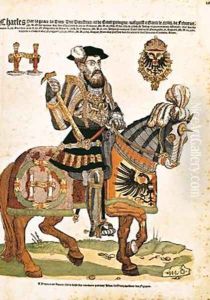Hans (the Elder) Liefrinck Paintings
Hans Liefrinck I, also known as Hans (the Elder) Liefrinck, was a prominent Flemish engraver, printmaker, and publisher during the 16th century. Born in 1518 in Antwerp, which was then part of the Habsburg Netherlands, Liefrinck was part of a family of artists and printmakers that significantly influenced the artistic landscape of the region. He was the son of Willem Liefrinck, who was also an engraver, and his family's artistic lineage continued with his own sons, who became engravers and publishers as well.
Liefrinck's work was characteristic of the Northern Renaissance, a period when the Renaissance art movement spread from Italy to the northern parts of Europe, including the Low Countries, Germany, and France. He became a master in the Guild of Saint Luke in Antwerp in 1545, which was the city's guild for artists and artisans. His career flourished in Antwerp, which was a bustling center of commerce and art, home to other renowned artists such as Pieter Bruegel the Elder.
As an artist, Hans Liefrinck I is known for his detailed engravings and etchings, which often depicted religious scenes, allegories, and landscapes. He was also an accomplished publisher, and his publishing house contributed to the spread of Renaissance ideas and imagery by reproducing works of prominent artists of his time. His prints not only served as artworks but also as vehicles for disseminating the visual culture of the period to a broader audience.
Liefrinck's engravings were executed with a high level of craftsmanship and often featured intricate details that were typical of the Northern Renaissance's focus on realism and naturalism. His works were collected and appreciated during his lifetime and have continued to be studied and valued by art historians and collectors.
Hans Liefrinck I passed away in 1573 in Antwerp. His legacy is preserved in the numerous prints and engravings that survive him, as well as in the continued operation of his publishing house by his descendants. The Liefrinck family remained active in printmaking and publishing for several generations, contributing to the cultural fabric of the Low Countries during a period of significant artistic and intellectual activity.
